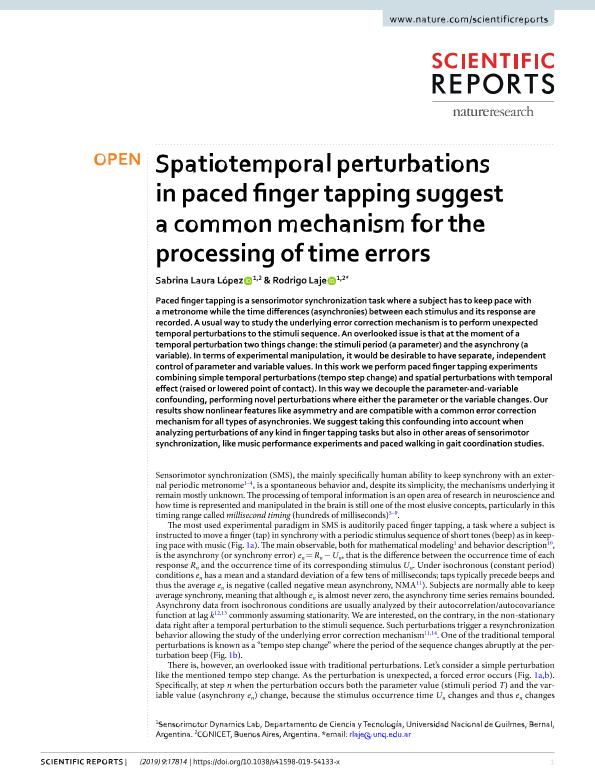Mostrar el registro sencillo del ítem
dc.contributor.author
Lopez, Sabrina Laura

dc.contributor.author
Laje, Rodrigo

dc.date.available
2022-10-26T14:07:52Z
dc.date.issued
2019-11
dc.identifier.citation
Lopez, Sabrina Laura; Laje, Rodrigo; Spatiotemporal perturbations in paced finger tapping suggest a common mechanism for the processing of time errors; Nature; Scientific Reports; 9; 1; 11-2019; 1-15
dc.identifier.issn
2045-2322
dc.identifier.uri
http://hdl.handle.net/11336/174922
dc.description.abstract
Paced finger tapping is a sensorimotor synchronization task where a subject has to keep pace with a metronome while the time differences (asynchronies) between each stimulus and its response are recorded. A usual way to study the underlying error correction mechanism is to perform unexpected temporal perturbations to the stimuli sequence. An overlooked issue is that at the moment of a temporal perturbation two things change: the stimuli period (a parameter) and the asynchrony (a variable). In terms of experimental manipulation, it would be desirable to have separate, independent control of parameter and variable values. In this work we perform paced finger tapping experiments combining simple temporal perturbations (tempo step change) and spatial perturbations with temporal effect (raised or lowered point of contact). In this way we decouple the parameter-and-variable confounding, performing novel perturbations where either the parameter or the variable changes. Our results show nonlinear features like asymmetry and are compatible with a common error correction mechanism for all types of asynchronies. We suggest taking this confounding into account when analyzing perturbations of any kind in finger tapping tasks but also in other areas of sensorimotor synchronization, like music performance experiments and paced walking in gait coordination studies.
dc.format
application/pdf
dc.language.iso
eng
dc.publisher
Nature

dc.rights
info:eu-repo/semantics/openAccess
dc.rights.uri
https://creativecommons.org/licenses/by/2.5/ar/
dc.subject
NEUROSCIENCE
dc.subject
TEMPORAL COGNITION
dc.subject
SENSORIMOTOR SYNCHRONIZATION
dc.subject
NONLINEAR DYNAMICS
dc.subject.classification
Otras Ciencias Biológicas

dc.subject.classification
Ciencias Biológicas

dc.subject.classification
CIENCIAS NATURALES Y EXACTAS

dc.subject.classification
Otras Ciencias Físicas

dc.subject.classification
Ciencias Físicas

dc.subject.classification
CIENCIAS NATURALES Y EXACTAS

dc.title
Spatiotemporal perturbations in paced finger tapping suggest a common mechanism for the processing of time errors
dc.type
info:eu-repo/semantics/article
dc.type
info:ar-repo/semantics/artículo
dc.type
info:eu-repo/semantics/publishedVersion
dc.date.updated
2022-10-26T10:47:03Z
dc.journal.volume
9
dc.journal.number
1
dc.journal.pagination
1-15
dc.journal.pais
Reino Unido

dc.journal.ciudad
Londres
dc.description.fil
Fil: Lopez, Sabrina Laura. Universidad Nacional de Quilmes. Departamento de Ciencia y Tecnología; Argentina. Consejo Nacional de Investigaciones Científicas y Técnicas; Argentina
dc.description.fil
Fil: Laje, Rodrigo. Universidad Nacional de Quilmes. Departamento de Ciencia y Tecnología; Argentina. Consejo Nacional de Investigaciones Científicas y Técnicas; Argentina
dc.journal.title
Scientific Reports
dc.relation.alternativeid
info:eu-repo/semantics/altIdentifier/url/http://www.nature.com/articles/s41598-019-54133-x
dc.relation.alternativeid
info:eu-repo/semantics/altIdentifier/doi/http://dx.doi.org/10.1038/s41598-019-54133-x
Archivos asociados
